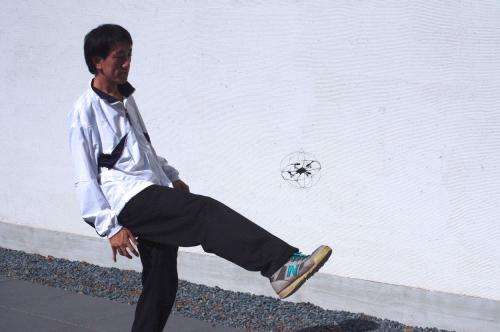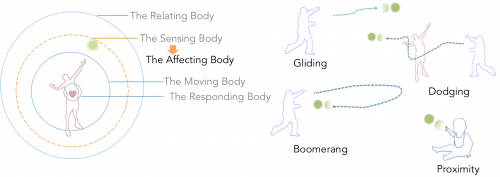March 20, 2014 weblog
HoverBall: Inventor redefines people-ball interactions using quadcopter tech

(Phys.org) —From early childhood on, humans use the ball as the fundamental tool for play, kicking it, throwing it, dodging it, sending it off on a roll. Japanese inventor Jun Rekimoto has other things in mind for a ball as a mainstay tool for future play. Why not, he said, widen its vocabulary? He has done so with his HoverBall, a ball that can hover and fly and be adapted to accommodate special needs.
He has reflected on how balls obey physical dynamics. "While this feature forms the foundation of ball-based sports we consider it might as well limit the possibility of them. For instance, the speed of balls could be too fast for small children, senior people, or people with physical disabilities." Rekimoto would like to see a flying ball based on quadcopter technology as becoming part of our play vocabulary. His ball can stay in the air longer and change its location and behavior according to sports game contexts. The ball, for example, could slow down for the elderly or young child during a game.
"With this technology," he wrote, "physical dynamics of a ball can be reprogrammed by sports designers, and new ball-playing vocabularies, such as hovering, anti-gravity, proximity, or remote manipulation, can be introduced to extend the way people interact with balls." Kei Nitta, Keita Higuchi, and Rekimoto authored a paper, "HoverBall : Augmented Sports with a Flying Ball." The team presented their work at the Augmented Human conference in Kobe, Japan, earlier this month.
The HoverBall has an embedded quadcopter, is 90 millimeters across and has a flight time of five minutes, said New Scientist. The ball is controlled remotely; it could be programmed to follow a particular flight path in future versions. He and his team intend to continue working on the HoverBall; more research is needed to come up with a ball that is durable enough against strong physical impact.

One specific use of the HoverBall is likely to be in exercise, rehab and elderly care. Japan in general has been building up an ample body of research in assistive technologies for the handicapped and the elderly. Analysts point to Japan's keen interest in assistive technologies; an aging population has been one of the drivers. People above the age of 65 will make up 40 percent of Japan's population by 2060, according to some estimates.
More information: lab.rekimoto.org/projects/hoverball/
© 2014 Phys.org


















